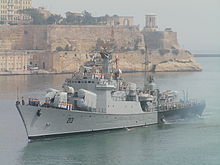- Libyan Navy
-
Libyan Navy Active 2011-present Country Libya Type Navy Size unclear Part of Military of Libya The Libyan Navy was the maritime force of the Libyan Arab Jamahiriya, established in November 1962. It was a fairly typical small navy with a few missile frigates, corvettes and patrol boats to defend the coastline, but with a very limited self-defence capability. The Navy has always been the smallest of Libya's services and has always been dependent on foreign sources for equipment, spare parts, and training.
Its first warship was delivered in 1966. Initially the effective force was limited to smaller vessels, but this changed after the rise of Colonel Muammar Gaddafi in 1969. From this time, Libya started to buy armaments from Europe and the Soviet Union. The Customs and Harbour police were amalgamated with the Navy in 1970, extending the Navy's mission to include anti-smuggling and customs duties. The total personnel of the Libyan Navy is about 8,000.
During the 2011 Libyan civil war several elements of the Libyan Navy were destroyed by NATO forces, including 8 warships in the night before 20 May and one on 17 August.[1][2] Two were also captured by the rebels at Benghazi.
Contents
Background
The Navy's primary mission is to defend the coast. A strengthening of the service was made in the 1970s; the Soviet Union sold six Foxtrot-class SSK submarines, and though two of them were only averagely serviceable, they became the main threats to the US Navy in the Mediterranean Sea. In the meantime, Libya bought four Russian Nanuchka class corvettes, that even in the export versions were well-armed and powerful ships. Another four Assad class corvettes were acquired from Italy. These had Otomat long range missiles (in the Mk.I version without datalink for in-flight course correction) and modern artillery. They were less well-armed as anti-aircraft ships than the Nanuchkas but, with a displacement almost twice that of a typical FAC, had ASW capabilities, with sonar and light torpedoes.
Actions
Libya's Navy first saw military action during an encounter with the United States Sixth Fleet in March 1986 in the Action in the Gulf of Sidra (1986), when one missile boat and a corvette were destroyed, and other ships were damaged by A-6s. Unusually, some of these attacks were performed, successfully, with CBUs like the Mk.20 Rockeye designed as an anti-tank weapon.
In July 1984, the Ro-Ro ferry Ghat is believed to have mined the Red Sea a few kilometres south of the Suez Canal. Approximately nineteen ships were damaged, including a Soviet container ship which was the first to be hit on 9 July. The Islamic Jihad Organisation took responsibility for the incident, however Egypt's President Hosni Mubarak did not believe the claims and blamed Muammar Gaddafi and Libya. Other sources agreed after it was learnt that the ship took fifteen days to complete a voyage that normally would take eight days, the head of the Libyan minelaying division was on board, and that, when inspected by French officials in Marseilles the aft door was damaged. Due to concerns about the safety and potential lost revenue from the canal, Egypt asked for assistance in sweeping the mines in a complex operation that involved mine-hunters from the French, British, Italian, Dutch, and US navies. The British located a Soviet-made mine, which was most likely sold to Libya after 1981 and was laid to cause problems for Egypt.[3]
Broadcast by US forces during the 2011 military intervention in Libya warning Libyan vessels of the naval blockade
During the 2011 Libyan civil war, Libyan Navy missile boats docked in Tripoli and began bombarding opposition controlled residential areas outside the city center leading to many casualties.[4] On 25 February 2011 naval officers in the rebel controlled areas declared their full support for the 17 February movement against the government.[5] Anti-government forces claimed that the Libyan navy shelled rebel positions during the Battle of Ra's Lanuf.[6] They also conducted a naval landing operation with four boats to flank rebel forces in Ra's Lanuf[7] On 9 July 2011, several light inflatable craft were destroyed by NATO warships when they were on their way to attack the rebel held city of Misrata. One of the NATO ships involved in the action was the HMS York.
On 17 August 2011, an RAF Tornado GR4 struck a moving Libyan Navy patrol boat with Paveway IV bombs. The boat had been observed supporting pro-Gaddafi forces during the Second Battle of Zawiya.[8]
Ships (1985)
- 1 × Vosper Mk.7 frigate, Dat Assawari, (Built in UK, 1×114 mm Mk.8 gun, 2×40 mm/70 AA guns, 2×35mm/90 Oerlikon, 2×Seacat SAM, 1×Limbo Mk.10 ASW mortar. Upgraded in the 80s with Aspide SAM, OTOMAT SSMs, new search radar and other equipment)
- 4 × Assad class corvettes (Built in Italy, 1×76 and 2×35 mm guns, 6 tls, 4 OTOMAT)
- 3 of 4 × Nanuchka class corvettes, one sunk by US Navy in 1985. One damaged 25 March 1986, repaired in USSR 1990
- Some light units of Osa and Jaguar class (16×SS-12 missiles and 2×40 mm)
- 3 × Polnocny class landing ships
- One LSD ship
- Some minor vessels
Ships (2006)
Frigates
2 × Koni class frigates (Type 1159) (one operational)
- 212 Al Hani: (Captured by Rebels at Benghazi)
- 213 Al Ghardabia: (struck by NATO in Tripoli Harbour 20 May 2011).
Armament:
-
- 4 × SS-N-2C Styx SSMs
- 2 × SA-N-4 SAMs
- 4 × 76mm guns
- 4 × 30mm guns
- 4 × 406mm torpedoes
- 1 × RBU-6000 A/S mortar
- 20 mines
Corvettes
- 416 Tariq-Ibn Ziyad: (Captured by Rebels)
- 418 Ain Zaara: (struck by NATO, 20 May 2011)
Armament:
-
- 4 × SS-N-2C Styx SSMs
- 2 × SA-N-4 SAMs
- 2 × 57mm guns MFPBs
MFPBs
9 × Combattante II fast attack craft (7 operational)
Armament:
-
- 4 × Otomat SSMs
- 1 × 76mm gun
- 2 × 40mm guns
12 × Osa class missile boats (Type II) (4 operational)
Armament:
-
- 4 × SS-N-2C Styx SSMs
- 4 × 30mm guns
Mine warfare vessels
9 × Natya class minesweepers (Type 266ME) (5 operational)
Armament:
-
- 4 × 30mm guns
- 4 × 25mm guns
- 2 × RBU 1200 A/S mortars
- 10 mines
- Acoustic & Magnetic sweep
In addition to several auxiliary and landing craft.
Oceanographic Research Ship
Nour, a former trawler converted in the 1970's. was stricken in 2002.
Submarines
6 × Foxtrot class submarine (2 left but probably abandoned)[9]
Libya received six Foxtrot-class military submarines from the Soviet Union in 1982. However, no submarine patrols were conducted after 1984, one submarine was reported sunk in 1993, and another one was abandoned in Lithuania due to international sanctions. Reports circulated about one submarine being refitted in 2003, but it is very unlikely that the submarines are still operational as of 2011.[9]
- Khoms (bombed by coalition air strikes on 20 May 2011, under opposition control)[10]
- Benghazi (under the opposition control)
- Misrata (under the opposition control)
- Tobruk (under the opposition control)
- Tripoli (bombed by coalition air strikes on 20 May 2011, under opposition control)[10]
- Derna (under the opposition control)
- Sirte (bombed by coalition air strikes on 20 May 2011, under opposition control)[10]
Ship maintenance and repair facilities
Facilities at Tripoli with foreign technicians for repair of vessels of up to 6,000 metric tons deadweight (DWT); a 3,200-ton lift floating dock; floating docks at Benghazi and Tobruk.
Notes
- ^ http://www.nato.int/nato_static/assets/pdf/pdf_2011_08/20110818_110818-oup-update.pdf
- ^ AFP: NATO hits 8 Kadhafi ships as Obama predicts demise
- ^ Levie, Howard. Mine Warfare at Sea. Dordrecht, NL: Martinus Nijhoff, 1992. 159-62.
- ^ Tran, Mark; Owen, Paul; Taylor, Matthew; Gabbatt, Adam; Walker, Peter (21 February 2011). "Libya uprising - live updates". The Guardian (London). http://www.guardian.co.uk/world/blog/2011/feb/21/arab-and-middle-east-protests-middleeast#block-75.
- ^ "Libya's Defectors". The New York Times. http://video.nytimes.com/video/2011/02/25/world/africa/100000000664162/tc-022511-libya.html?ref=libya.
- ^ Chris McGreal (10 March 2011). "Libyan rebels in retreat as Gaddafi attacks by air, land and sea". The Guardian (London). http://www.guardian.co.uk/world/2011/mar/10/libya-gaddafi-takes-ras-lanuf. Retrieved 11 March 2011.
- ^ "Gaddafi loyalists launch offensive". Al Jazeera. 11 March 2011. http://english.aljazeera.net/news/africa/2011/03/201131041228856242.html. Retrieved 11 March 2011.
- ^ http://www.military.com/video/operations-and-strategy/air-strikes/nato-jet-bombs-libyan-army-boat/1128937869001/
- ^ a b "Submarine forces (Libya), Submarines - Submarine forces". Janes. 10 November 2010. http://www.janes.com/articles/Janes-Underwater-Warfare-Systems/Submarine-forces-Libya.html. Retrieved 11 March 2011.
- ^ a b c http://newsinfo.inquirer.net/7826/nato-hits-8-kadhafi-ships
References
- Levie, Howard. Mine Warfare at Sea. Dordrecht, NL: Martinus Nijhoff, 1992.
- War machines encliclopedy, Limited publishing, in Italian version Armi da guerra.
- Annati Massimo, Al diavolo le mine!, RID magazine, Coop Riviera Ligure, Italy, June 2005.
External links
- (English) Libyan navy
- (English) Navy Inventory
- (English) Libyan Navy Inventory today
Military of Libya Libyan Arab Jamahiriya: Military of Libya · Libyan Air Force · Libyan Army · Libyan Navy · Revolutionary Guard Corps2011 Libyan civil war Part of the Arab Spring · Timeline (15 February–18 March · 19 March–31 May · June–15 August · 16 August–23 October)Forces Anti-Gaddafi forces (National Liberation Army – Free Libyan Air Force – NCLO) • Military of Libya (Libyan Army – Libyan Air Force – Libyan Navy) • Revolutionary Guard CorpsBattles CyrenaicaFirst Battle of Benghazi • First Battle of Brega • Battle of Ra's Lanuf • Battle of Bin Jawad • Second Battle of Brega • Battle of Ajdabiya • Second Battle of Benghazi • First Gulf of Sidra offensive • Third Battle of Brega • Battle of Brega–Ajdabiya road • Cyrenaica campaign • Fourth Battle of Brega • Ra's Lanuf raidFezzanSabha clashes • Fezzan campaign • Battle of Sabha • Ghadames raidTripolitaniaFirst Tripoli clashes • Battle of Misrata • First Battle of Zawiya • Nafusa Mountain Campaign (Battle of Wazzin • Battle of Gharyan) • Battle of the Misrata frontline (Zliten uprising • Battle of Zliten • Battle of Taworgha) • Zawiya raid • Msallata clashes • Rebel coastal offensive (Second Battle of Zawiya) • Ras Ajdir clashes • Battle of Tripoli • Second Gulf of Sidra offensive (Battle of Sirte) • Battle of Bani Walid • Second Tripoli clashes
NATO operations People Anti-GaddafiMustafa Abdul Jalil • Mahmoud Jibril • Abdul Fatah Younis • Abdul Hafiz Ghoga • Suleiman Mahmoud • Omar El-Hariri • Jalal al-Digheily • Khalifa Belqasim Haftar • Ali Tarhouni • Ali Abd-al-Aziz al-Isawi • Fathi Terbil • Abdelhakim Belhadj • Abu Oweis • Mahdi al-HaratiPro-GaddafiNATOOthersMohammed Nabbous • Iman al-Obeidi • Prince Mohammed El Senussi • Prince Idris bin Abdullah al-Senussi • Hussein Sadiq al MusratiPlaces, buildings
and structuresAbu Salim prison • Bab al-Azizia • Fist Crushing a U.S. Fighter Plane Sculpture • Giuliana Bridge • Green Square/Martyrs' Square • Maydan al Shajara • Mitiga International Airport • People's Hall, Tripoli • Rixos Al NasrImpact Casualties • Domestic responses (Gaddafi's response to the protests – Gaddafi's response to the civil war) • Human rights violations (Rape allegations) • Humanitarian situation (Refugees) • International reactions (International reactions to military intervention – Protests against military intervention – U.S. reactions to military intervention – International reactions to Gaddafi's death)Other Democratic Party (Libya) • Libyan Freedom and Democracy Campaign • Media • National Transitional Council • Topple the Tyrants • United Nations Security Council Resolution 1970 • United Nations Security Council Resolution 1973 • United Nations Security Council Resolution 2009 • United Nations Security Council Resolution 2016 • Voice of Free Libya • Zenga ZengaItalics denote operations or battles related to the military intervention in Libya
 Category ·
Category ·  Commons ·
Commons ·  Wikinews ·
Wikinews ·  WikiquotesCategories:
WikiquotesCategories:- Libyan Navy
- Navies by country
Wikimedia Foundation. 2010.






